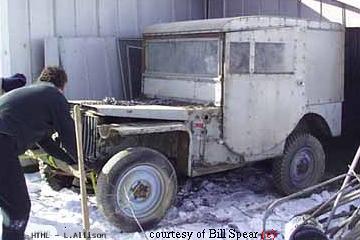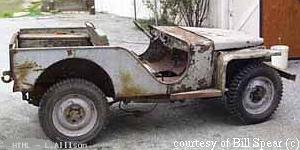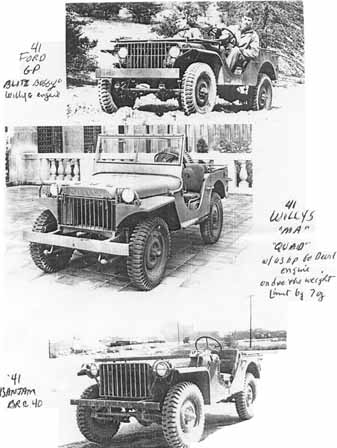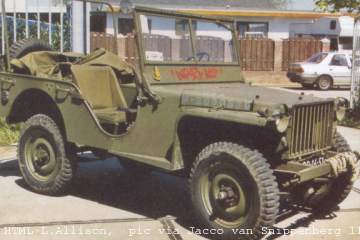Bantam Reconnaissance Car
Bill Spear is a Bantam car "enthusiast" (should that read fanatic?) so when Bantam Reconnaissance Car (BRC) #101 came up for sale, well he just had to buy it, didn't he? It is thought that perhaps 40 to 50 BRCs survive. This early Jeep, because that is what it is, has an interesting history now slowly being peeled back, as Bill writes, like layers of the onion.

The vehicle was delivered by Bantam to the Checker Cab Manufacturing Corp. of Kalamazoo Michigan possibly partially assembled. One theory is that Bantam was looking for more manufacturing capacity at about the time that it was being shafted by the military with all the major contracts to build Jeeps going to Willys Overland and to Ford. (See the Rifkind Report.)

The vehicle had been used as a factory run-about in later years, an enclosed body having been fitted (above). When this and reinforcing and/or cladding removed the Bantam's bodywork was revealed (right). A restoration is now in progress.
Naturally Bill is seeking information on the history of this and similar vehicles, not to mention a few missing parts.
Carburettor
It seems that there is an Australian connection - the Bantam used a Bendix Stromberg carburettor `BXOV-1' and after Bantam lost out, the tooling was sold to Holden for use on some early Holden cars c1948:
Holden used 3 carburettors that are designated as BXOV-1 in the
Bendix Stromberg book. The first was part #23-105D, and was used
from 1948-1959 in the 48/215 (the very first Holden - later known as
the FX), FX, FJ, FE & FC (early). The 2nd is part #23-3000, and was
used from 1959-1962 in the FC (late), FB, EK (with manual gearbox)
and EJ (with manual gearbox). The 3rd was part #23-3001, and was
used from 1961-1962 in the EK (with automatic transmission) and EJ
(with automatic transmission).
The first one (#23-105D)
is the one that works for the BRC in case you run into
a case of them still packed in cosmoline over there ... few of the
BRC guys have the right carbs. Ironically the carb was one of the
weak points of the Bantam design in the face off with Willys and
Ford - it didn't do well on steep uphill grades Stromberg didn't
apparently plan for this sort of climbing ability!
- Bill
Paint
I like the Gillespie Coatings from Longview Texas, 75602. My Bantam is weathered WWII Lusterless Olive Drab. They make 2 paint codes for this. One is #33070 & #319. Rapco is a distr. and there number is 1-817-872-2403 (Texas) or Army Jeep Parts and there number is 1-215-788-6012 (PA). I would call George Baxter at Army Jeep Parts and ask him what would best represent the earliest color - John [6/'00]
Chronology
[...] from my understanding of things anyway...and I'm going to pass this on to some of my Jeep enthusiasts so they can contradict my view of history or add to it if need be...
There were no production 1940 Fords. The Pygmy wasn't delivered for evaluation until Nov.23 and they didn't get a contract 'til 1941.
The first Jeep was the BRC#1 (Sept' 23, 1940) which was immediately followed by delivery of the remaining 69 units (different in that they still had the round nose, but had flat fenders so soldiers could sit on them in an emergency) all delivered by Dec' 17, 1940 to various Forts and Camps for evaluation (this number included 8, 4 wheel steering models). The QMC had invited Willys and Ford to develop "courtesy" prototypes and handed over Probst's full plans to them claiming they were now "Army property". Rep's of these companies also were given full access to the Bantam prototype during its testing at Holabird where it was examined in detail in the oil pit, measured and extensively photographed.
The Ford courtesy model (the Pygmy), almost indistinguishable from the second generation Bantam on the exterior was delivered Nov' 23, 1940 and began it's test series. (It was the first to have the square hood and recessed headlights we associate with Jeeps). It was approved on Jan' 6, 1941.
(Willys had submitted the grossly overweight Quad on the 13th and it failed it's tests miserably in spite of the impression sought to be created that the Willys engine was really impressive (In fairness, it was probably the designing around the engine that caused the problems). In fact in seven weeks of testing, the official Army report rejected it as unsatisfactory and stated that Willys had failures of practically every major component - clutch, transmission, transfer main shaft bearing, springs, steering pin, windshield, cooling and ignition systems, frame and the much vaunted "Go Devil" engine which had to be replaced twice (1.e. 3 engines in less than 8,000 miles) before the tests could be completed. Dispite the lack of a passing prototype Willys, after much lobbying in Washington, mysteriously, (along with Ford and Bantam) were given contracts to produce 1500 each.) Willys finally was able to deliver a prototype which would barely pass (seven ozs underweight) by June 7th. The Ford GP featured a 9N tractor engine! Ford and Bantam commenced production of their Jeeps in March of 1941 (although there is some evidence of Fords being around as early as February?). Thus, all of the Fords and most of the second generation Bantams were delivered and in the field before Willy's had a prototype.
Eventually in 1941 all of these 3x1500 unit orders were filled. The QMC kept raising the weight limits (in the opinion of IF Stone writing at the time to finally, somehow reach a high enough weight that Ford could produce a Jeep). Following these deliveries the Army had an 'all or nothing' shoot out. Since the weight limits had been raised so dramatically the Ford now appeared underpowered and the Willys larger engine which had prevented it from success in the past, now became an asset. Hell, everyone loves horsepower, and if you ask a GI not responsible for logistics and gas consumption etc. of course they will go for the hot rod, which they did. Willys got the nod for the whole 16,000. As noted, by now the specs had ballooned to 2400-lbs, putting the Bantam at a horsepower disadvantage having been designed to the original spec's (although there is nothing on the record saying the Bantam was underpowered). Understandably the Army wanted Jeeps with interchangeable parts, hence the all or nothing contract (which was of course changed once Bantam was boiled out of the equation - all of a sudden it became desirable to have two producers - Ford, ignominiously had to use Willys engines (hence the W on the GPW). After another small order of 1500 or so BRC's for the Russians (who BTW chose the Bantam having looked at all three), Bantam got shut out completely.
Well, all's well that ends well - assuming your army has unlimited
supplies of gasoline and the logistical ability to get it there the
Willys went on to become the Jeep we all know and love, and more
importantly, was one of the decisive weapons in
the war.

All of the "non conforming" Jeeps - both versions of the Bantam, the Willys MA's and the Ford GP's were immediately decommissioned and sent out on the lend lease program to all sorts of various places around the world where the war was breaking out - the Brits had Bantam in North Africa at some point - the Russians had Bantams - including some of the Round Nose ones one of which showed up in the Congo, on Television in 1960! The Russians had been supplying Lumumba with material which included this antique! Probst himself spotted it on TV one evening if you can believe it!
I used to think the Bantam was the most rare, but it is apparently the Willys MA which takes that prize (see, I told you they would never hold up!:~)) Someone told me there are only two in the Country. Well, that's one more than the original Bantam round nose of which there is only one known to exist, at the Smithsonian - I think the Ford GP's may be around but I don't know - most seem to be GPW's..
Just in case you're curious, I attach a picture of the three.
So, back to the 'who was first in combat' question - Bantam was
clearly the original design, the first to be commissioned into the
Army, and the first vehicle to be called a Jeep) By "previous to
WWII" I assume you mean the US entry into it? (Dec 8, 1941) - By this
time, as you can see, there were at least 6,000 "non conforming"
Jeeps floating around, and many more
Ford GPW's and
Willys MB's
from the 16,000 contract. I have found research indicating that several of
Bantam's first 1,500 unit run were sent off to lend lease countries
(I'm assuming England) - so this would have been in early to mid
1941 - and they could have made their way to Tobruk soon after
that - but sooner than the Fords in China? I don't know - photos with
dates would be of help - and certainly somewhere there must be
manifests and bills of lading etc from the Army as to when and where
these non conformists were sent - there is much to be discovered in
early Jeep history. [...]
- Bill [8/'00]
See [wmspear.com] for the unfolding history of this vehicle.
September 1941 Bantam, ex .ch, now .nl, restored by Ken Hage, — Jacco van Snippenberg 11/2002:

1941, .nl (2002)